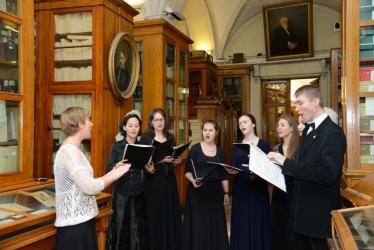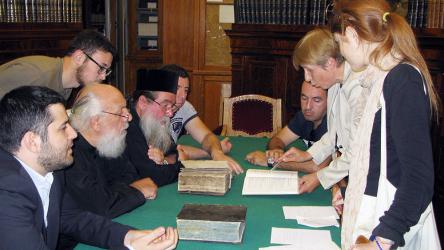Second Half of the 19th Century: Old Russian, South Slavic and Greek Manuscripts
Numerical superiority of Western manuscripts characterized the first half of the 19th century. Whereas, in the second half of the century, the library holdings were intensively replenished with Old Russian, Eastern and Greek codices. This can be associated with a large surge of scientific interest in such handwritten landmarks.
The year 1852 saw the acquisition of the "treasury of antiquities" amassed by the Moscow historian and writer Mikhail Pogodin. One of the richest and most precious from a scholarly viewpoint, this collection numbered more than 2 thousand manuscripts, about 1,500 acts and letters and several hundred autographs. The "treasury" also includes books composed of manuscript fragments from various monastery libraries, collected by the archeographer and historian P. M. Stroyev whose collection was purchased by Pogodin in 1842.In 1852, the Public Library was given a considerable number of Russian manuscript books from the private royal library founded by Catherine II and known as the Hermitage collection. By the mid 19th century, it numbered several thousand printed books, as well as more than 800 Russian manuscripts and about 500 manuscripts in Western European languages.
As a part of the Hermitage Collection, there were received manuscripts belonging to the known historian Prince Mikhail Shcherbatov. Among them were the famous Izbornik (Miscellany) of 1076, acts and deeds on the history of Siberia, documents on the "Russian interregnum".
Most of the collections of Old Russian manuscripts were incorporated into the Main Collection of Manuscript Books, which grew during the entire 19th century and was organized into 18 sections by format and theme. Over the course of the 19th century, the Main Collection was enriched with manuscripts collected by P. Karabanov (1852), V. Trekhletova (1860), P. Gundobin (1860), I. Sakharov (1863), I. Kupriyanov (1863), E. Bersenev (1865), N. Karamzin (1867 and 1879), A. Artemyev (1875), F. Sokurov (1876), V. Popov (1887), P. Bogdanov (1888), F. Buslaev (1893), P. Savvaitov (1897), Archimandrite Amphilochius (1900–1901). Nowadays, the Main Collection comprises over 8,000 handwritten books and fragments dating from between the 11th and early 20th centuries.
The most interesting collections of South Slavic manuscripts came into the Library during the second half of the 19th century. In 1868, the noted Slavonic scholar Alexander Hilferding presented the library with a collection of 101 Bulgarian, Bosnian and Serbian manuscripts ranging between the 13th and 18th centuries.
In 1874, the Library acquired the most valuable collection of Glagolitic books amassed by the Croatian philologist-Slavist and professor of theology Ivan Berčić. The collection includes 5 complete manuscripts of the 15th and 16th centuries, 154 fragments of codices dating from between the 13th and 16th centuries and 53 documents ranging from the 15th to 18th centuries, written in the cursive Glagolitic script. The I. Berčić Collection comprises the largest number of Croatian Glagolitic manuscripts as well as printed items kept outside of Croatia. Among them are a lot of rarities.
In 1858-1859, by order of Alexander II, the library received funding to purchase the German Byzantinist Constantin von Tischendorf's collection containing about two hundred Christian (Greek, Coptic, Arab, Syrian) and Jewish manuscripts, including dozens of bilingual palimpsests. Part of the collection was assembled by Tischendorf during his third trip to the Middle East, financed by the Russian Emperor Alexander II.Another extremely valuable acquisition of 1883 was a collection of the Russian traveller and Orientalist, the founder of the Russian Ecclesiastical Mission in Jerusalem, Bishop Porphyrius (Uspensky), comprising 435 Greek, Slavic, Arabic and other manuscripts. Most of them were fragments, including three leaves from the famous 4th century Codex Sinaiticus.
The last year of the 19th century saw the arrival of the collection of the head of the Russian Ecclesiastical Mission in Jerusalem, Archimandrite Antonin (Kapustin). The collection contains more than a hundred Greek and Slavic manuscripts.

